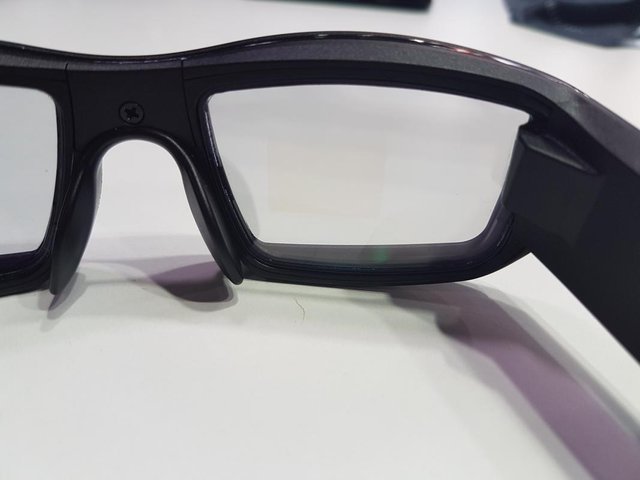
It's a good thing there are people out there too sensible to listen to everything Tim Cook says. Last year Mr We-Can't-Make-Quality-AR-Glasses-Yet claimed we don't have the actual tech to make AR glasses that are any good. I was lucky enough to get a go with the Vuzix Blade AR glasses at Mobile World Congress, and I can tell you that Tim Cook was either lying to cover Apple's tracks as it develops its own AR glasses, or completely wrong.
There was a bit of a queue for hands-ons with the Blade glasses, but I'm glad I stuck around instead of sneaking off to eat lunch. They are damn nice.

I should make it clear right now that I don't need glasses, so I was able to wear these over my regular face without any special prescription. That also means I'm not entirely used to wearing things on my face like that, which is why it was a good thing they didn't feel like they were weighing my head down. They sat pretty comfortably too, and didn't fall off while in use.
The only serious issue I had was the fact my fringe kept covering the glasses, which meant some of the AR and other camera-centric features weren't working properly. It's a problem I have with every single head-based gadget I've tried, because my hair just loves getting in the way.
The Blade is far less obvious that the likes of Google Glass or some AR specs shown off at tech shows over the past several years, but they're not going to pass for regular glasses. For starters they have a bit of a goggle-like look about them, and if that doesn't clue people in then the light shining into the right lens will.
Functionally the Blade offers a lot of different features, the main one being checking up on your various notifications without having to look at a phone. Other features on offer include mapping directions, video playback, and various augmented reality features. All of which are projected onto a little box in front of your right eye. Vuzix wouldn't tell me the exact make-up of the lens array (trade secret), but I imagine it's similar to other AR headsets like Hololens that involve layers of glass and light beamed somewhere in the middle to give the illusion of a floating hologram.
Controls are nice and easy too, with a touchpad on the right-hand arm that lets you control what's going on with swiping gestures. Swiping with one finger is the general gesture, letting you scrolls through things as you would on a phone. Swiping with two closes the app you're using and brings you can to the main screen. Tapping, obviously, is the command that lets the glasses you want to select something. Amazon's Alexa virtual assistant is also built in, so you can do things with your voice.

See that faint dark square in the right? That's the area you'll actually see the holograms when you're using. While it doesn't look like much, I found it interesting that the field of view is much larger than what Hololens has to offer, despite being a fraction of the size. I doubt the Blade has anything like the flexibility or functionality of Microsoft's headset, but it does means you don't have to squint and stare at a tiny little letterbox. The holographic content is right in front of your eye, and plenty big enough to take everything in without having to continually refocus your eyes.
The main thing to note about the Blade is that all the work and processing is done inside the glasses themselves, which currently run Android Marshmallow. Everything is in there, batteries included, which makes the fact they're fairly lightweight all the more impressive. Apparently the battery is enough to last through the day if you're just checking up on notifications. Naturally some of the more intensive features like AR, or watching video, are going to drain it a lot faster.
There is a micro-USB port that you can use to top the battery up, but naturally if you plan on doing that while you're wearing them that does mean there's an annoying wire to contend with.
The lenses do come with standard UV protection, in case of sunny days, and it will be possible for glasses wearers to buy a pair with inserts that match their prescription. Also built in are microSD expansion, head-tracking, and a noise cancelling microphone for taking calls.

The downside to the Blade glasses are that it's going to cost a lot. Like, iPhone X a lot, because the model I tried will go on sale for a whopping $1,000 ( £718). The idea is for the price to come down with subsequent models, but that much money isn't exactly pocket change. Not unless you're Bill Gates, or someone else who's so rich they don't know how much washing capsules cost.
Then again, the Blade isn't exclusively a consumer product. It has been designed for enterprise use in mind as well, which makes sense seeing as how that's the only place devices like Google Glass managed to have any sort of success.
If you do have that kind of money lying around, and you want to get your hands on some eyewear that's actually good, you'll be happy to know that the Vuzix Blade should go on sale later this year. Production is set to begin in Q2 2018, with release expected by Q3.
Flagged at 15%.
Plagiarism & copyright violation.
Direct copy of the article at http://www.gizmodo.co.uk/2018/02/mwc-2018-holy-crap-actual-working-ar-glasses-that-arent-completely-shit/
Downvoting a post can decrease pending rewards and make it less visible. Common reasons:
Submit